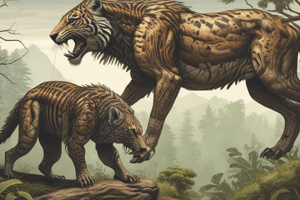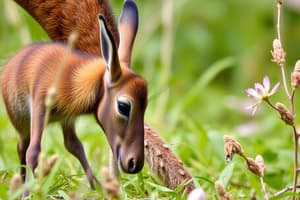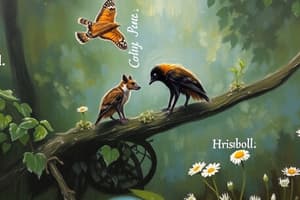Podcast
Questions and Answers
What is mimicry in the context of prey defense?
What is mimicry in the context of prey defense?
- Deception where a harmless species resembles a distasteful species. (correct)
- A strategy used by predators to attract prey.
- An adaptation that helps prey run away faster.
- A form of communication between predators.
Which of the following is NOT an adaptation plants may develop to protect themselves from herbivores?
Which of the following is NOT an adaptation plants may develop to protect themselves from herbivores?
- Thorns
- Tough leaves
- Bright warning colors (correct)
- Sticky hairs
Which example accurately represents a predator-prey relationship?
Which example accurately represents a predator-prey relationship?
- Corn smut affects corn plants
- Athlete's foot infects human skin
- A lion eats a zebra (correct)
- Zebra grazes on grass
Which type of symbiotic relationship benefits only one organism while the other is harmed?
Which type of symbiotic relationship benefits only one organism while the other is harmed?
In which symbiotic relationship do both species benefit?
In which symbiotic relationship do both species benefit?
What is a characteristic of herbivores?
What is a characteristic of herbivores?
Which is an example of commensalism?
Which is an example of commensalism?
Which adaptation helps prey avoid predators through camouflage?
Which adaptation helps prey avoid predators through camouflage?
What defines a community in an ecological context?
What defines a community in an ecological context?
What is the outcome of competition among organisms?
What is the outcome of competition among organisms?
Which of the following best describes predation?
Which of the following best describes predation?
What role do adaptations play in predation?
What role do adaptations play in predation?
Which of the following is NOT considered an ecological resource?
Which of the following is NOT considered an ecological resource?
How does predation affect population size in an ecosystem?
How does predation affect population size in an ecosystem?
What is the predator in a predatory relationship?
What is the predator in a predatory relationship?
Which characteristic could be an adaptation of prey to avoid being captured?
Which characteristic could be an adaptation of prey to avoid being captured?
What do termites provide to the bacteria living in their gut?
What do termites provide to the bacteria living in their gut?
What type of relationship do ants have with acacia shrubs?
What type of relationship do ants have with acacia shrubs?
What is a defining characteristic of commensalism?
What is a defining characteristic of commensalism?
Which of the following is NOT an example of an ectoparasite?
Which of the following is NOT an example of an ectoparasite?
How do barnacles benefit from their relationship with whales?
How do barnacles benefit from their relationship with whales?
What is the primary effect of parasitism on the host organism?
What is the primary effect of parasitism on the host organism?
What type of organisms are considered endoparasites?
What type of organisms are considered endoparasites?
What do triggerfish provide for smaller fish in their environment?
What do triggerfish provide for smaller fish in their environment?
Flashcards
Community
Community
All the living organisms found in a specific area.
Species Interactions
Species Interactions
Interactions between organisms in a community that can have a strong impact on the ecosystem.
Competition
Competition
A struggle between organisms for the same limited resource.
Resource
Resource
Signup and view all the flashcards
Predation
Predation
Signup and view all the flashcards
Predator
Predator
Signup and view all the flashcards
Prey
Prey
Signup and view all the flashcards
Predator Adaptations
Predator Adaptations
Signup and view all the flashcards
Mimicry
Mimicry
Signup and view all the flashcards
Parasitism
Parasitism
Signup and view all the flashcards
Mutualism
Mutualism
Signup and view all the flashcards
Commensalism
Commensalism
Signup and view all the flashcards
Herbivores
Herbivores
Signup and view all the flashcards
Symbiosis
Symbiosis
Signup and view all the flashcards
Predator-Prey Relationship
Predator-Prey Relationship
Signup and view all the flashcards
Camouflage
Camouflage
Signup and view all the flashcards
Ectoparasite
Ectoparasite
Signup and view all the flashcards
Host
Host
Signup and view all the flashcards
Endoparasite
Endoparasite
Signup and view all the flashcards
Food
Food
Signup and view all the flashcards
Obligate Mutualism
Obligate Mutualism
Signup and view all the flashcards
Study Notes
Species Interactions
- A community encompasses all living organisms within a specific area.
- Organisms within communities constantly interact, significantly impacting the ecosystem.
Types of Species Interactions
- Competition: Occurs when organisms (same or different species) vie for the same resources (food, water, light, nesting sites, or space) in the same location and time.
- Predation: One organism (predator) hunts and consumes another (prey). The predator kills and eats the prey.
- Symbiosis: A close, long-term relationship between two different species.
- Mutualism: Both species benefit from the relationship. Examples: Flowers and insects, where flowers provide nectar and insects spread pollen. Hippos and birds, where birds eat insects on hippos' backs.
- Commensalism: One species benefits, while the other is neither harmed nor helped. Example: Triggerfish and smaller fish, where the triggerfish moves rocks for smaller fish to feed. Barnacles and whales, where barnacles benefit from the constant water flow around whales.
- Parasitism: One species (parasite) benefits, while the other (host) is harmed. The parasite obtains nutrition from the host. Example: Some bacteria, protists, and intestinal worms like tapeworms. External parasites like ticks, fleas and lice.
Competition Details
- Competition can result in a winner and a loser. The winner thrives, and the loser may struggle or perish.
- Resources are anything essential for survival: food, water, shelter, etc.
Predation Details
- Predation is a powerful force in communities, defining relationships in food webs and regulating population sizes.
- Predators have adaptations (e.g., sharp teeth, claws, acute senses) that enhance their hunting success.
- Prey species have adaptations (e.g., camouflage, speed, poison) to avoid being caught.
Mimicry
- Mimicry is a form of deception used by prey to avoid predators.
- A harmless species mimics a harmful or distasteful species.
- Examples: King snakes mimicking poisonous coral snakes, viceroy butterflies mimicking monarch butterflies.
Plants and Herbivores
- Herbivores are animals that eat plants.
- Adaptations: Plants develop defenses (e.g., thorns, spines, bad taste) to deter herbivores from eating them.
Predator-Prey Examples
- Notes are provided in a table format
Symbiotic Relationships
- Symbiosis is a close, long-term relationship between organisms of different species.
- Details of each relationship type listed above
Parasites
- Parasites are organisms that live on or in a host organism, benefiting from the host while harming it.
- Ectoparasites: Live on the exterior of their host. Examples: Fleas, ticks, lice, and leeches.
- Endoparasites: Live within their host. Examples: Tapeworms, some bacteria, and some protists.
Studying That Suits You
Use AI to generate personalized quizzes and flashcards to suit your learning preferences.




